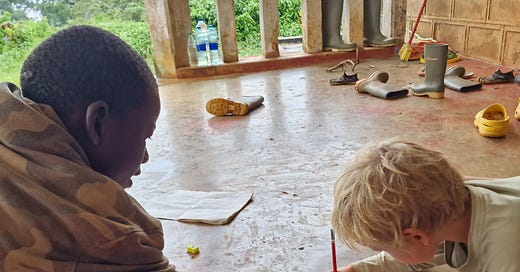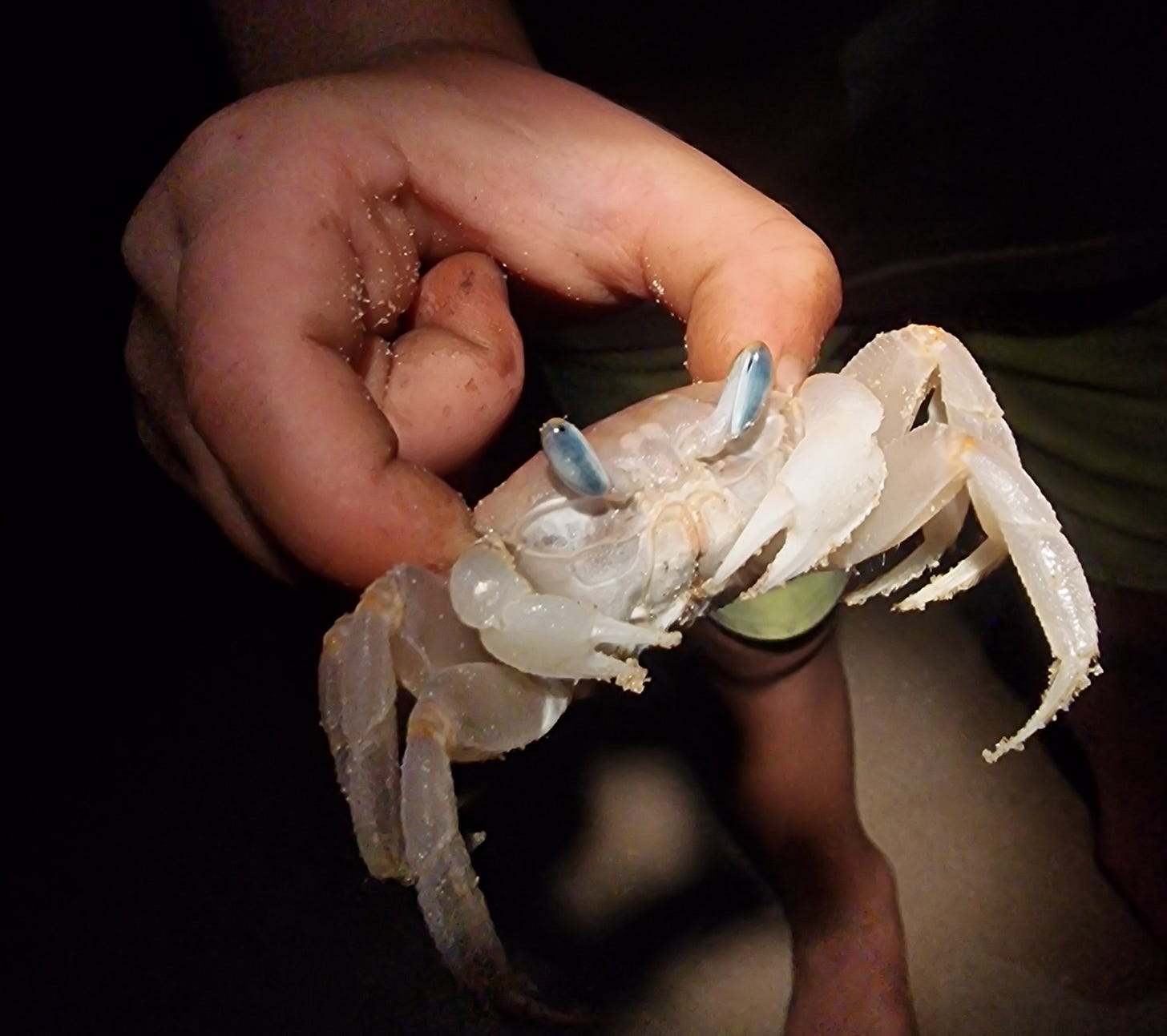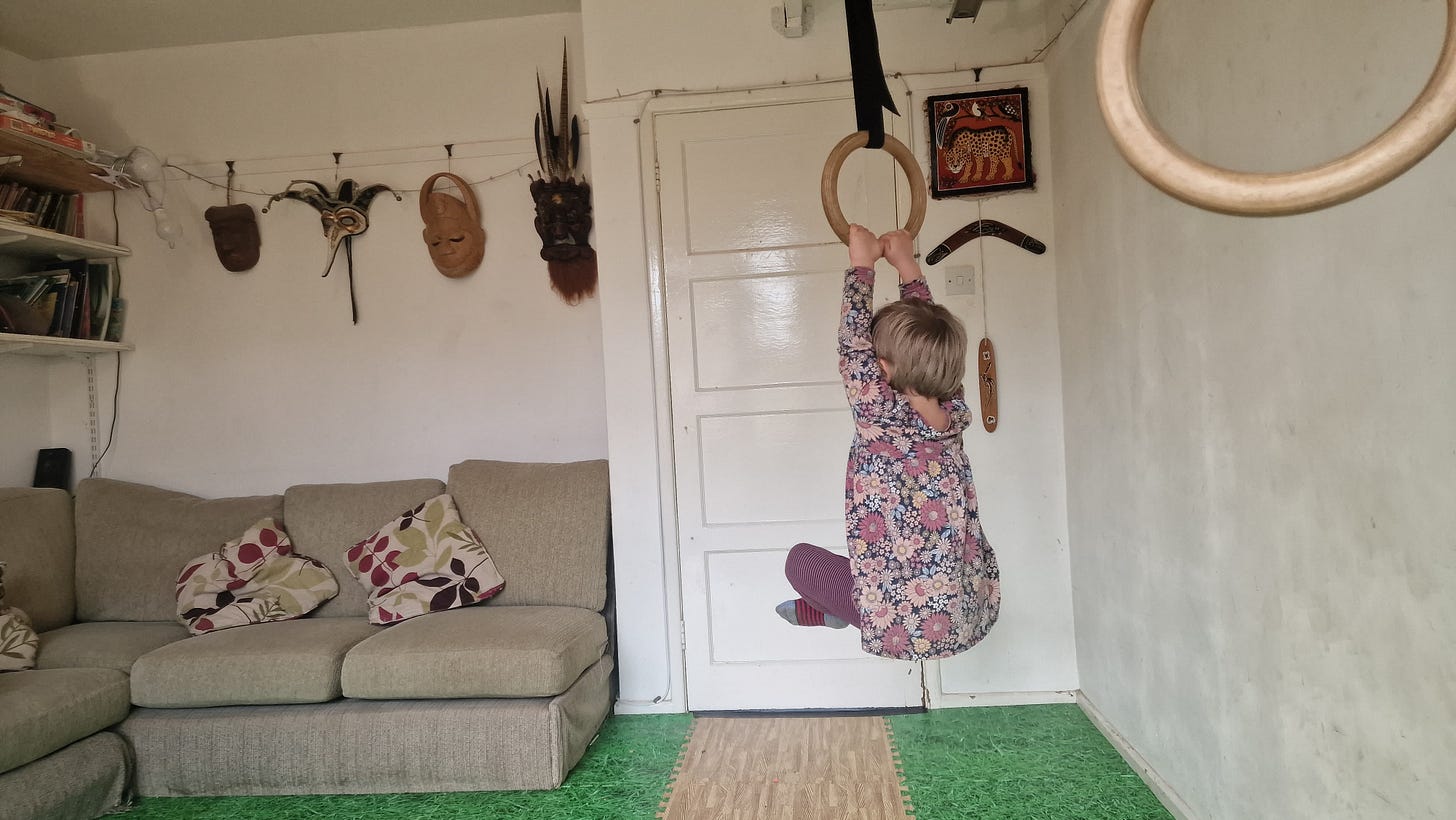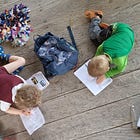Today's children barely move their arms. Here's how to help.
‘Little monkeys’ need to be, well, little monkeys...
The shadows of the palm trees were growing into the Indian Ocean and the sand was gritty under my fingernails as I wiped the oil out of our five trusty bowls. The children put sand on the fire and then ran out onto the beach. Thousands of the fastest land invertebrates in the world were starting to wake up. And three children were ready for them.
The light from their head torches startled, scanned, and shrank as the pursuits began. Ghost crabs, wearing their eyes on stalks above their heads, were worthy adversaries. And they wouldn’t be captured without a fight. Every night, at least one child would come running screaming back with a crab attached to their hand. Once separated, child and crab could be gently released in opposite directions. We wore our smug adult smiles. “They’ll learn!” we assured each other. “They’ll learn.”
And sure enough, they did.
But they didn’t learn what we thought they’d learn.
A month later, the night time pursuits were as fast and furious as ever. They were catching more than ever before, but now they almost never got pinched.
Two months later, they were catching lizards off walls.
Three months, dragonflies out of the air.
The small, fast, hardy wildlife of Tanzania was training their reflexes, dexterity, and catching techniques, but it wasn’t the start of the journey. Their fine motor skill development started much, much earlier…
Children need to get their arms in the right place to get their fingers in the right place
We often talk about ‘gross motor skills’ and ‘fine motor skills’ as though they are two separate categories. But they are actually steps in a process. Gross motor skills are the foundation of fine motor skills.
(nb. If “Gross” and “Fine” sound like archaic ways to say “Big” and “Small” to you, that is because they are. The terms were coined in the early 1900s and haven’t been updated since. And don’t even get me started on the phrase “coined”!)
Put simply, if you can’t move your arm and hold it in the right position, it doesn’t matter how well your fingers move. And that’s why gross motor skills are so important.
The NHS lists seven categories of gross motor skills for babies. These are:
Tummy time
Rolling
Sitting
Moving from lying to sitting
Crawling
Moving into standing
Walking
Notice something? Which of those are about developing arm strength? Crawling, obviously - but this is not a gross motor skill that all babies do. In many traditional cultures, and in ours at certain periods of our history, crawling is very much discouraged.
The other two which have an element of arm movement are moving between positions - from lying to sitting, and into standing. The NHS thinks children need enough arm strength to allow them to change position and get up. Wow. Such power they want people to have! Such grace. To me, that seems a very low bar to set.
If we’re thinking about creating a solid base onto which to build fine motor skills later, then children need stronger gross motor skills than that. To develop those, children need plenty of opportunities to move. And some, especially those with delays or disabilities, will have an even higher requirement for movement. That’s an important point to not miss: often, the more difficult a kid finds movement, the more they need.
Children develop strong arms from hanging by them
The gross motor skill that is missing from the NHS list above is hanging by the arms.
Babies can hang by their arms well before they can walk. In fact, even newborn babies have a grip reflex that is strong enough to hold their own bodyweight.
Just like walking gives the legs the mechanical loads they need to build well-formed bones and muscles, arms mechanical loads from hanging. The major loads that legs expect are compressive, and the major loads that arms expect are tensile. We are primates after all, and our musculoskeletal system has evolved to enable us to climb and hangswing through the trees (brachiation, if you want the technical term).
Traditional cultures enable children to develop arm strength before they have to develop finger dexterity
Arm loading in children in most traditional cultures starts very early. In some cultures, babies hang from their arms from their earliest babyhood, but more on that another time. Suffice it to say, nearly all babies outside of WEIRD cultures rely on arm strength from a young age. This is because babies are more often carried by adults.
How does this affect their arm strength, I hear you ask? If you’re being carried in someone else’s arms for a distance, then both you and the person carrying you have an easier time if you hold on. Some people have even considered whether a major reason that humans still have hair on their heads is to give carried infants something to grip on our otherwise unusually-slippery-for-a-primate bodies.
(nb. I think preventing sunstroke might have something to do with it too, but as with all evolution it was probably a multi-purpose adaptation).
So, babies have to support themselves and hold on from an early age. Without chairs, baby bouncers, or walkers, babies learn to walk by reaching up to hold adult hands. Their ability to hold their weight through their arms prevents them from falling with every stumble.
And, as soon as they are mobile, hanging by the arms continues to be a part of life. Everywhere we went, we saw children, sometimes very tiny children, climbing trees, swinging on creepers, and hanging from structures in the villages. Why? Because it’s fun! Why? Because nature has made it fun! Why? Because nature makes things that are good for us fun, and hanging by their arms is good for kids!
Because of all this play, arm strength grew at the same rate the children did. And with that arm strength, catching bugs and animals was easy…
WEIRD cultures give fewer opportunities for children to develop arm strength
Long-time readers will have some idea where I’m about to go with this: Growing up WEIRD (cultures that are Western, Educated, Industrialised, Rich, and Democratic) is very different from growing up in a traditional community. Through a combination of risk aversion and the worship of comfort, we’ve utterly changed the movement environment in which kids live, and hence, the long term health they build. I’ll show you what I mean.
To start with, we’ve made a lot of convenient and fun devices that reduce the work of our babies’ arms.
Prams are a good example. Very few of us carry babies in our arms for any appreciable distance. We’ve got a pram, buggy, or stroller for that! Or a sling, if we’re feeling particularly Earth Mother. None of these require arm movement. That’s not our fault as parents - we didn’t have the childhood to grow strong arms either, so carrying a baby is really hard work. No-one does it in our culture, and while we might see prams (etc.) as the result of having tired arms and shoulders, they could also be viewed as the cause.
There’s another big difference in our culture. We entertain babies with toys, rather than with the environment around them. How many baby toys have you seen that are marketed as “Improves fine motor skills!”? Ever seen one that says “Great for gross motor skills!”? Yeah, me neither, and I don’t think that’s just because of the double meaning of the word gross. Our recent (i.e. last 200 years) focus on academic over physical competence means that we prioritise fine motor skills, like writing, far more than our kids’ ability to do larger actions (so called “physical literacy”). But both, as we’ve seen, are vital.
We also teach walking very differently. Many traditional cultures help babies learn to stand much earlier. This requires a lot of work from their tiny arms as parents or other children hold their hands up to help them up hundreds of times a day. WEIRD cultures tell us to leave the baby lying down as much as possible, and let them stand at their own pace. Which, of course, they will do when their legs are much stronger and their arms don’t have to work so hard. They learn on the furniture or perhaps in their Jumperoo.
And then there’s the lack of opportunities outside. It’s not just that we don’t use them - they simply don’t exist. Trees in public places almost all have their lower branches cut off to prevent children climbing them. And we don’t have many strong creepers to swing and bounce on where I live!
Finally, the very topical elephant in the room and the thing that at least some readers are thinking: Most WEIRD kids wouldn’t go climb trees even if they had the arm strength of Simone Biles. They’d prefer to stay on the ground, preferably inside, on their phone (or ‘device’ if we’re being pedantic). The dopamine-engineering epidemic that’s causing this is the topic of another article, and I won’t go into it here, but yes: that is also an issue for gross motor skill development and, hence, for adulthood joint and bone health. Can’t learn to hang if you’re not outside hanging about.
What can we do about it?
Fortunately, if we are creative about looking for them, WEIRD environments still offer plenty of opportunities for children to move their arms more.
Got a little baby? Try consciously carrying them in your arms a little bit more. It’s a workout for the parent (or carer, or older sibling, or friend. Let’s not be WEIRD about this), but it also quickly becomes a workout for the baby too when they start to join in! Just make sure you change positions plenty of times so you’re moving your body well too.
Got a slightly older baby? Look for things for them to hang from with their hands. Oven door handle is normally perfect height, but also normally attached to an oven, which is less perfect. Reinforcing a shelf, or putting towel rails low down on the walls (like a tiny ballet studio) works really well.
In possession of a mobile toddler? To the park! Help them on the monkey bars from a young age. I have a friend who has the strongest upper body of anyone I’ve ever met. She puts it all down to time spent at the park opposite her house when she was growing up. Proximity = time spent, and for a young child distances more than about 100m are just “far”. Something to think about when moving house.
Are your children a bit older? Is there anywhere in your house to hang a few gymnastics rings? That means hours of laughing their head off while hanging, swinging, and spinning at breakneck speeds. Also popular: pull up bars, ladders, and ropes upon which you can pretend to be a sloth.
We tend to think about the size of houses and gardens in terms of ‘square metres’ rather than ‘cubic metres’, but once you consider how important climbing and hanging are to kids’ development and adults’ health then thinking in volume becomes more obvious. How much movement can you fit into your house? What about your garden? Is it just area?
Building strong shoulders, hips, backs, arms and legs sets a solid foundation of gross motor skills onto which fine motor skills can be layered. It’s honestly true that climbing trees improves handwriting. But, more than that, gross motor skills and strength set children up to become adults that are more confident, less likely to get injured, can breathe more easily, and eventually, are less likely to have degenerative joint problems in old age.
It is, perhaps, time to let ‘little monkeys’ be little monkeys.
Want to hear my partner and I discuss our experiences of helping children develop upper-body strength? We have a podcast where we use the topic from the previous post and give context and examples to help bring it to life. There’s also a weekly news section where we dive into interesting research into child development from the previous week.
This is the sound of Sunday evenings in our house!
You may also like:
Notes
WEIRD children have worse fine motor skills than you’d expect: https://www.sciencedirect.com/science/article/abs/pii/S0167945715300804
Katy Bowman is a biomechanist who has some fantastic articles on the loads that bodies require: https://www.nutritiousmovement.com/articles/more-movement-for-babies-and-kids











Just started this one and came to say-only a couple paragraphs in-that in the US the FDA removed crawling as a milestone 1-2 years ago (what is time now lol) and that seemed very suspicious to me.
So, I agree with the importance of brachiation, but I'd argue it should not be at the expense of tummy and crawling time which is absolutely foundational for movement and also woefully minimized in western culture. Skipping crawling is not the end of the world but it's detrimental for movement development. It's also my understanding that hanging by the arms at the baby stages needs to be trained slowly and gently without full bodyweight to avoid elbow and shoulder injuries.
Also, the arms of a parent carrying a baby are not doing the same exercise at all compared with hanging. Myself and many parents I know struggle with chronic wrist pain from carrying out kids. (A word of advice about that: hold the kid while relaxing your wrists+hands+fingers as much as possible.)